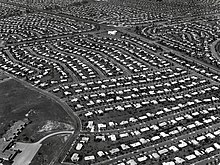
Two historic houses in Minneapolis. Photo: McGhiever via Wikimedia Commons
Time to note a major victory: the City of Minneapolis is on board with YIMBYism in a serious, substantial way. Minneapolis has become the first major U.S. city to adopt a comprehensive plan that eliminates single-family-only zoning districts. And, although its amended zoning still caps out development of many parcels at just three units, it will still (in broad theoretical terms) allow builders to triple the number of housing units within those neighborhoods. That’s impressive. And since housing markets are more regional than municipal, and Minneapolis is the largest city in its region, I predict this legislation (presuming it passes the remaining hurdles) will have a salutary effect on housing affordability throughout the Twin Cities, for years to come. This really is great news.
In a related story, the Oregon Legislature may soon consider a Democratic bill to eliminate single-family-only zoning districts in cities with a population of 10,000 or more. The fact that the lead sponsor is the House Speaker indicates the degree of acceptance that our kind of zoning analysis has attained, politically, in a very short time. Of course, there is pushback, as there always is in politics. But once it comes into focus, the picture is pretty clear, and economy, equity, and the environment all call for one basic solution: expanding the latitude of property owners to build more housing in response to the need for … more housing. People see the need to stop protecting a calcified status quo that is working for fewer and fewer people.
When I first started writing here about exclusionary zoning laws and their distortion of housing prices (way back in 2010, when I was a law student at Rutgers) it remained a very arcane issue. The basic nexus between restrictive land use policies and declining affordability had been well documented in New Jersey case law through the Mount Laurel decisions of the 1970s and 80s. But outside the local community of housing activists, the slow crisis of an artificial, regulatory shortage of housing units in growing metropolitan regions was hardly on anyone’s radar. Today, housing activists on both right and left accept this common-sense analysis: zoning laws that limit development of new units play a major part in the lack of housing affordability in growing cities.
I got into this issue because I saw people being displaced from their long-term neighborhoods across the New York & New Jersey region in the late 1990s and early 2000s — and nobody with a voice seemed to be noticing. Since then, the soaring cost of housing options in metropolitan America has become, perhaps, the most glossed-over factor among the myriad economic challenges facing Millennials. Now, finally, we are making some real progress, and although we’re not there yet, I am more optimistic than ever.
Cheers to everyone who is out there working on the front lines.


 Sad to report that a promising and important piece of legislation
Sad to report that a promising and important piece of legislation 




 In a Times piece called “
In a Times piece called “